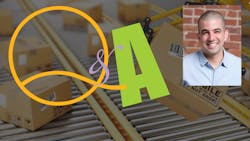Q&A: An Energy Efficiency Tool can Futureproof a Full-Stack, Automated Assembly Line
At a Glance:
- The Eclipse Carbon Optimization (ECO) framework is a methodology designed to quantify a technology’s future sustainability and carbon reduction potential.
- Bright Machines was one of 11 companies identified as addressing carbon intensity within the manufacturing sector.
- Lior Susan, co-founder and CEO of Bright Machines, explains how microfactories enable manufacturers to localize supply chains and reduce global shipping.
With physical industries accounting for 75% of U.S. greenhouse gas (GHG) emissions, net-zero goals are contingent upon investments in the decarbonization of these industries.
This statement, made by venture capital firm Eclipse Ventures in a press release, was intended to draw attention to a novel instrument that shows promise at assessing the potential environmental and economic value for emerging industrial technologies.
READ MORE: Designing a Turnkey Vision-Guided Bowl Feeder Cell
The Eclipse Carbon Optimization (ECO) framework is a methodology designed to quantify a technology’s future sustainability and carbon reduction potential. Eclipse Ventures touts the effectiveness of the due-diligence instrument for weighing opportunities in carbon-intensive physical industries.
The ECO framework is based on the open platform tool CRANE, which was developed by the climate non-profit Prime Coalition. Users are able to analyze the future potential environmental value proposition of new technologies in the same way they are used to assessing the economic value proposition. The ECO framework was applied to 11 venture companies and the results were published to highlight the combined carbon reduction potential.
According to the ECO framework, three primary components are considered:
- The estimated total GHG emissions in the market addressed by portfolio technology.
- The estimated GHG emissions reduction potential of the portfolio technology.
- The estimated market penetration rate of the portfolio technology.
The ECO Report also outlines how participating companies technological advancements are transforming the physical world. Combined, participants have the potential to reduce annual emissions by more than 200 million metric tons of carbon dioxide equivalent (MMtCO2), or 4% of total U.S. emissions, by 2040. That’s the equivalent of removing about ~44 million internal combustion engine passenger vehicles from the road, stated the report.
“What the report confirms is that Bright Machines Microfactories, when delivered as a flexible and scalable full-stack automation solution, can help modernize one of the world’s biggest industries by enabling manufacturers to localize supply chains, which is both economically and environmentally advantageous over the long run,” noted Lior Susan, co-founder and CEO of Bright Machines, a participant in the study.
In the following Q&A with Machine Design, Susan discusses the measurements made available through the ECO framework, and shares insights into the ways Bright Machines leverages computer vision, machine learning, 3D simulation and robotics to fundamentally change the flexibility scalability and economics of production.
Machine Design: Tell us a bit about Bright Machines. Please give us your elevator pitch on the Bright Machines Microfactory. What problem does this technology solve?
Lior Susan: Bright Machines is pioneering an innovative approach to intelligent, full-stack manufacturing. Our core offering is the Bright Machines Microfactory—a complete, programmable assembly line that is powered by the Brightware Platform and offers a full-stack solution. Microfactories solve the problem of manufacturers needing many workers to do repetitive tasks, which is expensive and leads to slowdowns and mistakes. Our solution intelligently automates tedious assembly and inspection tasks, making it possible to build more units at a lower cost and with higher quality, and make changes to production as needed. Furthermore, workers are freed up to pursue more interesting, high-value roles in the production process.
MD: What does your vision of the factory of the future look like?
LS: Our vision for the industry is what we call Software-Defined Manufacturing. This involves advancing automation and software solutions that apply data and algorithms to a wide range of manufacturing operations, making them more efficient and effective over time. In the factory of the future, production will mainly be handled by machines, while humans direct the machines and do other high-level tasks. These machines will continue to get smarter to do better work and will deliver valuable data that employees can use to further improve how products are made.
MD: Is your automation framework intended to eliminate manual labor?
LS: It’s a misconception that manufacturing automation will eliminate the need for manual factory work and reduce jobs. Most researchers and academics agree that there will in fact be a net increase of jobs as a result of automation technology. Jobs on the factory floor don’t go away, they evolve. Instead of doing a task like inserting a screw, a worker might now be able to direct the machine’s work and evaluate its output and quality.
READ MORE: “Making Automation Easy Starts With the Design Process”
As machines continue to get smarter and capable of assembling more products, reskilling the workforce is key. Bright Machines offers low code/no code software so employers can re-skill employees in running production recipes without having a background in software engineering.
MD: Please explain how Bright Machines’ flexible, software-defined automation supports companies in their efforts to localize their supply chains. What are the associated advantages?
LS: Today manufacturers are increasingly looking at options to bring their production closer to home to mitigate risks and increase flexibility. They can also save money and be more sustainable by reducing reliance on global shipping. Bright Machines Microfactories are flexible and modular and can be set up in a variety of settings, taking up minimal space.
The cost of implementing automation varies little across geographies, which makes it valuable to manufacturers moving production to regions with higher labor costs. One notable example is Stanley Black & Decker, which has publicly announced their desire to reduce manufacturing in China by 60%. Over the next several years, they have committed to relocate product lines back to the U.S. and other countries as a core pillar of their “Make Where We Sell” strategy.
MD: Explain how the Eclipse Carbon Optimization (ECO) Framework is used to assess the potential of various emerging industrial technologies to reduce annual carbon emissions. How can product manufacturers incorporate the ECO Framework methodology into their assembly?
LS: As companies and communities look to reverse climate change, improve economic resiliency, and accelerate digital transformation, the Eclipse Carbon Optimization (ECO) Framework is a new tool that assesses the potential of various emerging industrial technologies to reduce annual carbon emissions. An industry first, pioneered by Eclipse Ventures, ECO helps investors identify the full promise and impact of technologies by quantifying sustainability and carbon reduction potential alongside economic ROI.
There are existing tools that measure the resiliency and efficiency of new technologies, but ECO gives investors and manufacturers a comparable methodology to assess sustainability and future economic potential of such technologies. The ECO Framework is based on CRANE, an open platform, soon-to-be open source tool developed by leading climate nonprofit Prime Coalition. Manufacturers and their investors have access to the CRANE tool to replicate what Eclipse Ventures has done.
Furthermore, it is also important for the industry to continue the sustainability conversation and be aware of the many ways that manufacturing contributes to emissions and can help reduce the damage.
MD: According to the press release, “Bright Machines was one of the companies identified as addressing carbon intensity within the manufacturing sector, showcasing that automation allows for far higher yields, reduced transportation requirements due to local production, and less waste.”
LS: In the ECO Framework, Bright Machines is identified as addressing carbon intensity within the manufacturing sector, since automation allows for far higher yields, reduced transportation requirements due to local production and less waste. The framework confirms that our microfactories enable manufacturers to localize supply chains and reduce global shipping, which is both economically and environmentally advantageous.
READ MORE: How Emerging Technologies Can Transform the Hospital Experience
Factories using automation also take up less physical space and energy. Smaller footprint, automation-based factories typically require less floor space and can be located closer to end-customer markets and can be designed to be more energy efficient and transportation light—reducing pollution and minimizing excess production and waste. Today’s automation can also increase quality and lower defect rates, reducing scrap and harmful waste produced by factories.
The ECO Framework found that Bright Machines has the potential to reduce intensity by 51% per unit carbon or 5.5 MMtCO2 annually—the equivalent of planting 6.5 million trees annually.
MD: Which manufacturing verticals are most likely to adopt the Bright Machines Microfactory?
LS: Our team works with 30 global manufacturing companies, including original equipment manufacturers (OEMs), original design manufacturers (ODMs) and contract manufacturers. We serve customers across industry segments including networking infrastructure, automotive components, industrial controls, general-purpose machinery, data centers and consumer goods. In the four years since Bright Machines was founded, we have achieved strong momentum, deploying over 100 microfactories to factories worldwide.
MD: What are the limitations of the Bright Machines Microfactory?
LS: The only limitation is the size of the product that can be assembled. We focus on smaller units with heights up to 220 mm and weight up to 30 kg. As demand for enabling technology like intelligent automation continues to grow, we continue to build out our technology stack to give customers new opportunities to build efficiencies and understanding into their factory operations.
A key focus is continuing to expand the microfactories’ capacity to produce products for new verticals and to build in even more flexibility capabilities so that customers can get more use out of the same hardware and software. Finally, the microfactory’s built in feedback loop allows it to gather data on accuracy and efficiency, making continuous improvements possible.
About the Author

Rehana Begg
Editor-in-Chief, Machine Design
As Machine Design’s content lead, Rehana Begg is tasked with elevating the voice of the design and multi-disciplinary engineer in the face of digital transformation and engineering innovation. Begg has more than 24 years of editorial experience and has spent the past decade in the trenches of industrial manufacturing, focusing on new technologies, manufacturing innovation and business. Her B2B career has taken her from corporate boardrooms to plant floors and underground mining stopes, covering everything from automation & IIoT, robotics, mechanical design and additive manufacturing to plant operations, maintenance, reliability and continuous improvement. Begg holds an MBA, a Master of Journalism degree, and a BA (Hons.) in Political Science. She is committed to lifelong learning and feeds her passion for innovation in publishing, transparent science and clear communication by attending relevant conferences and seminars/workshops.
Follow Rehana Begg via the following social media handles:
X: @rehanabegg
LinkedIn: @rehanabegg and @MachineDesign

